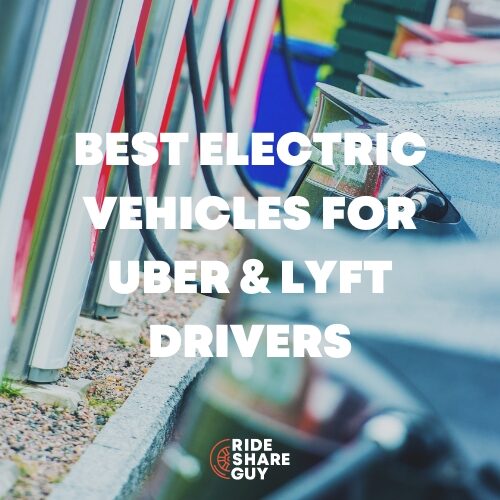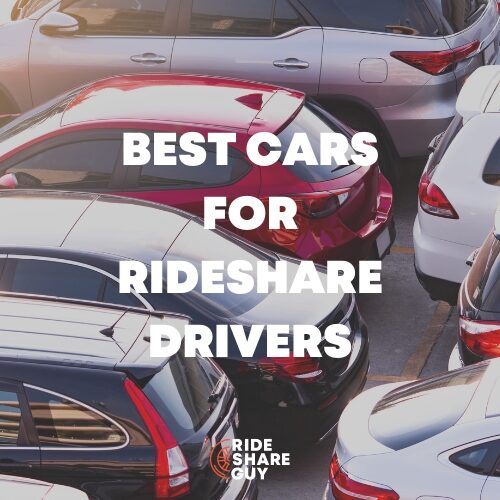👉 Do you use an EV to drive for rideshare or delivery? Join our Facebook Group for EV gig drivers for discussions about the current state and future of EVs.
Uber and Lyft’s recent zero-emissions goal announcements have caused many drivers to consider (or reconsider) driving an electric vehicle. However, one worry among drivers is getting stranded due to lack of a charge and cost of electric vehicles. Senior RSG contributor Paula Gibbins interviewed one Florida EV driver about his experience, recommendations, and costs below.
Electric vehicles have been in the spotlight as of late with both Lyft and Uber looking to switch their platforms to 100% EVs by the year 2040. This is great news for the climate, but drivers who don’t have experience with electric vehicles may be a bit skeptical.
In order to get to the bottom of how electric vehicles can work for drivers, I interviewed Curt, a driver who has been using an all-electric Chevrolet Bolt to rideshare drive for about 2.5 years.
Learn more about electric vehicles:
- Our interview with Lyft’s Director of Sustainability on Lyft’s transition to electric vehicles
- The 5 best electric vehicles for Uber and Lyft drivers
- Lyft announces 2030 goal of transitioning its platform to EVs
- Want to try out an EV without buying one? Check out our Rideshare Vehicle Marketplace for options!
Uber and Lyft Commit to Going All-Electric
It was recently announced that both Uber and Lyft have the goals of moving their platforms toward using all electric vehicles in the coming years. Lyft announced it first in June. and following their announcement was one from California’s Air Resources Board (CARB) in July who had submitted a proposal pushing for Uber and Lyft to go 60% electric by 2030.
Next came Uber’s announcement. The only real difference is that Uber announced incentives for drivers to switch to all electric vehicles to go along with the company’s goal of 100% of rides taking place in zero-emission vehicles by 2030. The incentives would allow for up to $1.50 extra per trip for drivers who use or switch to all electric vehicles.
Learn more about how Uber Green will work for (and pay) drivers below: Uber Launches Uber Green! A Service That Pays Drivers More!
Harry recently spoke to Sam Arons, the Lyft Director of Sustainability, about what is happening. Arons said that the number of EVs out there on the platform right now is fairly low, but they are hoping to find a path toward success to adopt electric vehicles into their platform.
With the help of tax credits and government programs, Uber and Lyft both hope the transition will be easier for drivers. Note: neither Uber nor Lyft is making the transition mandatory, but it’s clear the direction for drivers will be toward EV and rewarding drivers who drive EVs.
What’s it Like Driving an Electric Vehicle for Rideshare?
Reader Curt drives a Chevy Bolt, one of our recommended EVs for drivers. Jumping into Curt’s experience, most passengers don’t even notice that he’s driving an EV!
“That’s the thing about the Chevy Bolt—it is quite innocuous,” said Curt. “To combat that and make things interesting, I have a goofy note to pax taped to the back of the right front seat headrest. It is written as though authored by the car (“Sparky”) rather than me the driver.”
(If you want to read his car’s written backstory, check it out here.)
Overall, Curt loves that his EV is pretty low maintenance. He said:
“The Bolt has been very reliable – all it has needed is a software update early on (under warranty), a minor axle noise issue resolved by the dealer for $100 (their minimum) and a set of tires at 82k. Odometer now at 112k…no other repair or maintenance costs other than cabin air filters. Local tire company does free rotations and balance. The owner’s manual lists just three maintenance items – tire rotations, cabin air filter, and a coolant swap at 150k.”
Curt drives in Jacksonville, Florida, so he’s not sure how the Chevy Bolt would handle snow, but he guesses it would do decently well partially because of its 3,500 lb. weight thanks to the 1,000 lb battery.
He went on to say, “Ground clearance is ok for a small car, but I occasionally decline a trip on really poor privately maintained unpaved roads owing to concern of bottoming out and damaging the battery…that’s a 1 ride per thousand occasion, so not a major issue.”
Want to try out an EV without buying one? Check out our Rideshare Vehicle Marketplace for options!
The Best Reasons to Drive an Electric Vehicle for Rideshare
If you want a reason to drive an all electric vehicle for rideshare, here’s what Curt says are the main attractions:
- No oil changes
- No transmission
- No timing belt, valvetrain, camshaft, etc.
- No gas tank, fuel pump, injection system
- No emissions controls and inspections
- No exhaust system (pipe, muffler, catalytic converter)
- No brake work
For the “No brake work” one, Curt said, “While the Bolt has 4 wheel disc brakes, I don’t anticipate ever needing work done on them for the life of the car. Why? Because the conventional brake system is very rarely actually used during normal driving – the electric motor and battery system handle all routine braking tasks…recharging the battery while doing so and thereby increasing range.”
Now, as far as the Uber Green program and other incentives to drive all electric on Uber, here’s what Curt had to say about those:
“Uber Green isn’t available in Jacksonville, but the Uber zero emission incentive ($1 extra per ride for 12 months / 4000 rides) begins 9/21/2020, motivating me to restart. Covid seems finally to be on the wane here (for now)…an extra $1 – $1.50 is considerable – Jax market rate is about $0.60 / mile and $0.09 / minute – quite low relative to the rest of the U.S. In higher cost / higher paying markets, the extra may make less difference. Our minimum of $3.19 per ride is so low that an extra buck per trip will make short trips much more worthwhile.”
 How Much Does it Cost to Charge an Electric Vehicle?
How Much Does it Cost to Charge an Electric Vehicle?
To answer this, Curt said there are different EV charging categories. Here’s how it breaks down:
- L1 – this charging method uses the EVSE cable that came with the Bolt. It plugs into any standard 120 volt receptacle, so typically no additional infrastructure cost. However, it adds range at just 3-4 miles per hour, so while it can work fine for those drivers that only go 30-40 miles per day, it is impractical for all but the most light duty rideshare drivers
- L2 – this charging method requires an aftermarket “box” (formally “EVSE” or Electric Vehicle Supply Equipment) that costs $300 – $600 and requires a dedicated 40-60 Amp 240 electric circuit. It charges at a rate that adds range at 25-40 miles per hour, so it easily fully recharges the Bolt battery overnight.
A home L2 charger can also add a reasonable amount of extra range for full time drivers who work an AM shift followed by a PM shift…such as 4:30 AM to 10 AM and then 3 – 7 PM. The interval from 10 to 3 should add enough range to get through the PM shift.
According to Curt, he uses an L2. He says of installing the new charging method:
“I’m electrically handy so installed it myself as well as the required 240V circuit. My home, like many single-family homes, has the electric panel in or near the garage, so adding the circuit isn’t a major ordeal. A non-handy driver might spend $1000 – $2000 for an L2 EVSE and an electrician to wire the circuit.”
3. L3 – this charging method is only available on the road – it converts commercial electric power – 3 phase 230 or 480 Volt alternating current to direct current at high voltage for direct application to the car’s battery. Charging speed is 100-225 miles of added range per hour.
The typical L3 recharging session involves recharging from 10-20 % up to 70-80% in 25-50 minutes. Those figures are typical for a Chevy Bolt.
Teslas are much more advanced in that regard – their supercharger network is both more widespread and much faster, but Tesla (in theory) prohibits rideshare driver use of their system.
The non-Tesla L3 DC fast charging network is growing fairly quickly, but charging using it is still somewhat time consuming and quite expensive – 3-6x faster but also 3-6x more costly than charging at home. According to Curt:
“Therefore, I have found that it is rarely worthwhile to extend a rideshare shift by stopping at an L3 fast charger…by the time I’m done partially recharging, rider demand has fallen and I realize I would have been better off just going home.
The occasions where L3 charging availability has been crucial are those occasional very long rides to adjacent metro areas…without a 20-40 minute spent at an L3 charging session out of town, I would not have been able to make it home.”
As far as his electric bill goes, Curt said it costs him about $0.025 per mile to recharge at home, which is his preferred location to recharge.
To put it into a rideshare perspective, he said that a heavy rideshare month of driving 1,000 or more miles per week increases his monthly electric bill by about $100. But, if he were driving a vehicle that needed gas, he could have spent $300-500 on gas and an oil change.
What Happens if You Run Out of a Charge Before You Make it Home?
Curt stated:
“I have never been stranded. A couple of times I have found myself 40-50 miles from home with an indicated remaining range of 40-50 miles. While that sounds like a potentially stressful situation where I’d have to go find a fast charger (often way out of my way and time-consuming and somewhat costly) there is an easy alternate solution – head home but avoid freeways. Driving 30-45 mph on secondary roads almost doubles EV range compared to driving 60-70 mph on freeways.”
That’s a pretty cool tip to keep in mind. And like he said above, braking helps recharge, so stopping at stop lights and signs would help get you home without worry.
If Curt does need to recharge while out for the day, he’ll find a quick charge station, but those are often out of his way and more expensive than he’s willing to pay in his low paying market.
Thoughts on Driving an EV for Rideshare
Here are a few other things Curt said he enjoyed about having his Chevy Bolt and driving for rideshare:
“In a nutshell, I never considered driving rideshare until I bought my Bolt EV. Once I had it, I so much enjoyed driving it that I started Uber/Lyft for an excuse to go do more of something I enjoyed.
My 4,500 rides have more than paid for the car. My family and I don’t depend on my driving to make ends meet, but I’ve really missed it during Covid. We just bought a 2nd Chevy Bolt for our 16 year old daughter – it is used / off lease and cost about half what I paid for the first one. I think that if I return to AM shift rideshare driving I can pay for the 2nd car in less than a year, aided by the Uber zero emissions incentive.”
In addition, “it is a hoot to drive – instant torque and regenerative braking make every trip fun to drive. While no one likes being stuck in traffic, a small consolation exists in that in most cases an EV stuck in traffic gets better ‘MPG’ (actually ‘miles per kiloWatthour’) than it does at higher speeds…the exact opposite of gas cars.”
“I’m also curious to learn how far a Chevy Bolt can go…there is a website that tallies up very high mileage Chevy Bolts, and I’m in 8th place there. I’d like to be number one and resuming rideshare driving could get me there….quarter million miles…10,000 rides?”
Overall, it seems like Curt has found a lot of pros to driving an electric vehicle for rideshare. If you’re in the market for a ‘new’ car for rideshare, you may be able to find a lightly used electric vehicle (like the Bolt) at a good price. You will want to factor in the cost of updating your electrical panel to charge your vehicle faster, but other than that, compare it to the money you will save on maintenance and gas costs.
Those drivers who live in apartments or don’t have a garage/access to an electrical panel, maybe find this considerably more difficult. RSG hopes Uber, Lyft and governmental agencies seriously consider additional incentives to bring charging stations to more locations and make them more widely available.
Would you drive an electric vehicle for rideshare? Why or why not?
-Paula @ RSG
Learn more about electric vehicles:
- Our interview with Lyft’s Director of Sustainability on Lyft’s transition to electric vehicles
- The 5 best electric vehicles for Uber and Lyft drivers
- Lyft announces 2030 goal of transitioning its platform to EVs
- Want to try out an EV without buying one? Check out our Rideshare Vehicle Marketplace for options!
👉 Do you use an EV to drive for rideshare or delivery? Join our Facebook Group for EV gig drivers for discussions about the current state and future of EVs.




